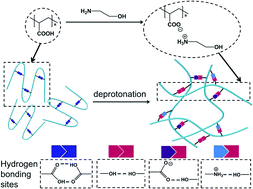A water-soluble, adhesive and 3D cross-linked polyelectrolyte binder for high-performance lithium–sulfur batteries†
Abstract
Binders as a necessary component in sulfur cathodes play an important role in maintaining the mechanical integrity/stability of electrodes and anchoring lithium polysulfide (LiPS) for lithium–sulfur (Li–S) batteries. In this work, we developed a low-cost and water-soluble polyelectrolyte binder (D-PAA/C-EA) by simply neutralizing commercially available polyacrylic acid (PAA) with a small molecule, ethanolamine. D-PAA/C-EA is expected to form a 3D cross-linked network by virtue of the abundant electrostatic interaction and hydrogen bonds between –COO−, –NH3+ and –OH. Compared to cathodes with PAA and poly(vinylidene fluoride) (PVDF) binders, cathodes fabricated using D-PAA/C-EA exhibit strong adhesion strength to accommodate the volume change of active materials, comparable or improved polysulfide adsorption, good dispersion of composite nanoparticles and high porosity to allow efficient electrolyte wetting and fast Li+ diffusion. Consequently, a remarkable capacity of 638.6 mA h g−1 at a high rate (10C) is achieved for Li–S batteries with a sulfur loading of 1 mg cm−2. Even at high sulfur loadings of 3 and 5 mg cm−2, the discharge capacities can remain at 920.7 and 679.0 mA h g−1 at 0.2C after 100 cycles.



 Please wait while we load your content...
Please wait while we load your content...